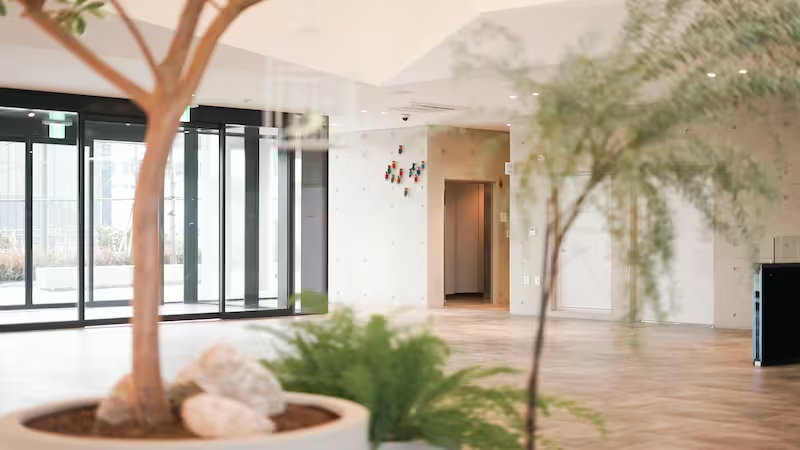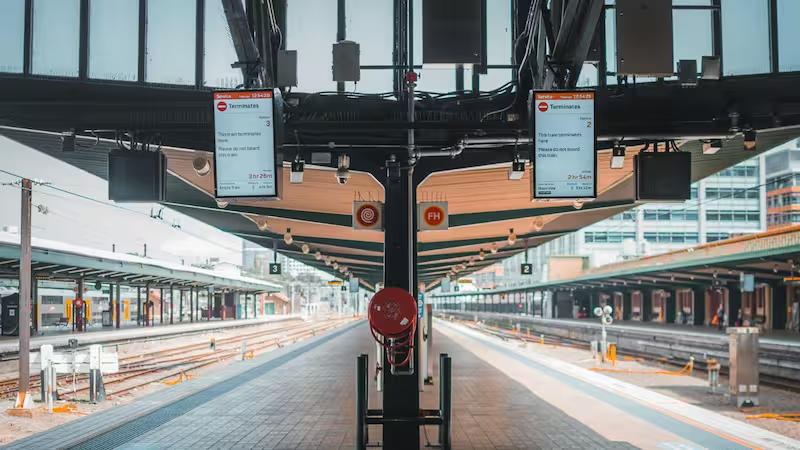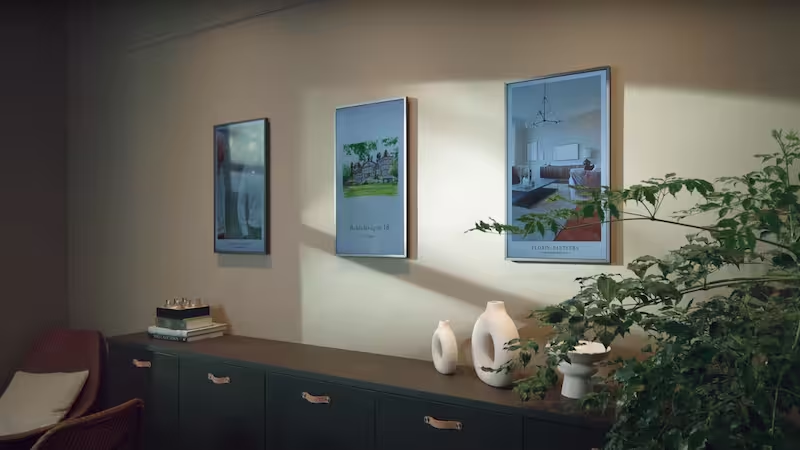
Table of Content
Does this sound like you right now?
“I need to keep my store messaging fresh, but print signage feels like a time sink.”
“With online competition on the rise, my in-store conversion needs a bigger boost.”
“I run promotions so frequently that posters barely have time to breathe.”
eMarketer found that over 65% of customers spend more in stores with engaging digital signage, and about 38% are willing to exceed their planned budgets when prompted by dynamic, up-to-date visuals.
But if you rely on traditional print materials, you’re locked into slower turnaround times and higher production costs, often at the expense of revenue and brand impact. For fashion retailers juggling tight deadlines, seasonal launches, and ever-changing online campaigns, that’s a major stumbling block.
Retail digital signage flips the script. It keeps your store in sync with real-world trends, drives bigger baskets by highlighting timely offers, and scales your best ideas across multiple locations instantly.
Below, we’ll explore how it works, why it’s taking off, and what strategies top chains are using to keep their store experiences as agile as their online platforms.

The Strategic Role of Digital Displays in Fashion Retail
Always On-Brand, Always On-Time
Fashion marketing moves fast, but that doesn’t mean you want to lose sight of consistent branding. Digital displays for retail let you maintain a cohesive look and feel across hundreds of stores, all while allowing quick local updates. If sales teams decide to run a limited-time offer, they can push those changes to every store in minutes instead of waiting weeks for new printed signage.
This same flexibility helps global chains tailor messages for different climates, events, or cultural moments. Warm-weather promotions can pop up in Miami while a sister store in London cycles in new fall arrivals. And because motion naturally draws the eye, these screens have a better chance of catching a shopper’s attention than a static poster would.
Retail as Media: Transforming Storefronts into Marketing Channels
Forward-thinking fashion chains treat their storefronts like digital billboards and leverage window-facing LED screens and video walls to broadcast content that draws in crowds. For example, luxury brand Telfar’s New York flagship features a giant LED screen wall streaming Telfar TV, which effectively turns the brand’s content-obsessed fans into “living mannequins” in the store.
Some retailers also run real-time promotions synced with online campaigns – an approach H&M used when it announced a surprise Charli XCX concert via social media and on digital screens in select stores just 30 minutes before showtime.
The ability to tease campaigns or drop exclusive content in-store generates buzz and foot traffic without any print signage lead time. Brands can effectively localize content to create local impact.
Read also: How to Increase Foot Traffic in a Retail Store?
Key Applications of Digital Displays in Fashion Stores
Lookbooks That Move
Why settle for static photos when you can show high-definition video clips or slideshows of new collections? These “living lookbooks” help shoppers visualize how items actually fit and move. Some stores pull in live social media feeds or runway footage, giving the brand’s aesthetic a sense of energy and immediacy.
Dynamic Wayfinding
In-store navigation displays provide up-to-date directional cues, highlighting recent arrivals or special in-store events. These wayfinding screens can adapt instantly: if you open a new pop-up or reorganize a department, the signage can let everyone know in real time. They reduce confusion and help customers explore more of the store.
Price-Driven Messaging
Digital displays are perfect for spotlighting current discounts, limited-time offers, or newly marked-down items. Bright, rotating graphics grab attention better than plain paper signs, and this content can be updated or scheduled automatically.
If you set up a flash sale on jackets for 24 hours, your digital screens can reflect that promotion the moment it goes live, creating a sense of urgency and nudging shoppers to act. Studies show this approach not only moves discounted goods faster but can also drive impulse purchases in nearby categories.
Style by Weather, Time, or Location
Shoppers’ fashion choices often hinge on context. If it’s raining, people think about raincoats and umbrellas. On sunny afternoons, a window display might shift to show sunglasses or sundresses. Scheduling digital signage software makes these updates automatic.
Whenever a local weather app signals a change, the displays pivot to match. Some brands also schedule content by time of day, for example, promoting professional attire during weekday mornings and then featuring casual evening looks.
Fashion Chains Winning with Digital Displays: Use Case Highlights
ZARA: Fast Fashion, Faster Content
Zara’s famed speed-to-market extends to its in-store digital experience. In newer flagship stores, such as one on the Champs-Élysées in Paris, Zara has installed large LED video walls and interactive digital signage to immerse shoppers in its latest campaigns. One LED wall even projects morphing digital art, giving a sense of spectacle to the checkout area.
Zara also experimented with augmented reality (AR) in over 100 stores worldwide, letting shoppers use their phones to see virtual models wearing new looks. According to the company, these kinds of experiences help convert casual store visitors into devoted fans who appreciate the extra interactivity.

H&M: Immersive and Interactive Experiences
In its Regent Street location in London, H&M installed a massive indoor LED wall that spans an entire section of the store. This wall exhibits changing digital art that reacts to environmental cues, such as time of day or nearby movement, making shoppers feel like the space itself is responding to them.
In high-profile flagships like Times Square, H&M also experiments with interactive “smart mirrors” that let customers virtually try on outfits or snap selfies that transform into personalized digital magazine covers.
Read also: The Power of Video Wall Advertising for Modern Brands
Nike: Tech-Forward Storytelling and Community Building
The new Nike Rise concept stores in locations like Guangzhou, Seoul, London, and the first U.S. Rise store in Miami, Nike introduced a platform called Sport Pulse, essentially a network of giant screens that display real-time local sports data, user stats, and live social content from Nike’s apps.
These screens create a wow factor and also reinforce Nike’s connection to the athlete (or aspiring athlete) consumer. The screens double as storytelling platforms by running a motivational Nike campaign video, then next highlighting a community run that’s happening in the city.
Shoppers leave not just with products but with a sense that they have engaged with the Nike lifestyle. And when it comes to conversion, a well-placed screen that highlights a full outfit or explains a product’s tech benefits often tips the scale for upsells.
Why Digital Signage Works So Well for Fashion Chains
Shorter Time to Market for Campaigns
Digital displays drastically cut down the lead time to roll out new campaigns or adjust messaging. Now, a single digital content push can update all locations in minutes. This agility means fashion marketers can respond instantly to trends (e.g., a celebrity wearing a product) or react if something isn’t selling (swap in a new promo by tomorrow). Fast fashion brands especially benefit since they can advertise new arrivals the moment inventory hits stores.
Higher Conversion and Upselling at the Point of Influence
Digital signs actively drive purchasing decisions in-store by influencing shoppers at that critical moment when they’re browsing. Bright, dynamic screens grab attention and can introduce products or promotions the customer wasn’t considering.
Showcasing outfit pairings, flash discounts, or product benefits, signage can upsell shoppers on additional items (“Complete the look with these accessories”) or higher-value choices.
Unlike static signs, digital content can use motion and urgency cues (countdowns, limited offer banners) that spur impulse buys. All of this translates to higher conversion rates in fitting rooms and at displays.
Boosted Brand Perception through Tech-Forward Storytelling
The use of digital installations in stores sends the message that a brand is innovative, exciting, and in tune with contemporary consumers. Fashion chains are finding that signage is not just selling products but also the brand’s image and lifestyle. For instance, integrating interactive or social content screens can refresh a legacy brand’s image.
Shoppers, especially Gen Z, perceive a retailer with immersive screens as more engaging and relevant than one with bland paper signs. The rich storytelling possible (playing videos from runway shows, behind-the-scenes designer interviews, style tips) creates an emotional connection and a “cool factor” that boosts brand loyalty.
Read also: Gen Z Shopping Habits – Everything You Need To Know

Seamless Sync with Digital Marketing (Omnichannel Consistency)
One of the strongest arguments for retail digital signage is how it links the physical store to the digital marketing ecosystem. In an omnichannel world, customers should recognize the same themes and visuals in-store as they saw on Instagram or the website. Digital displays make this possible by bringing online content into the store in real time.
Launching a new season collection on your e-commerce and social channels? You can simultaneously play the campaign video on a loop at store entrances and in window displays, so the experience is unified.
Moreover, digital signage can integrate live feeds – for example, a brand’s X (Twitter) or Instagram content can stream on a social wall, effectively merging digital community buzz with the brick-and-mortar environment.
How Look Digital Signage Supports Fashion Retail at Scale
Implementing all these digital display capabilities is possible with the powerful Look Digital Signage software across hundreds of fashion stores. Here’s how Look addresses the needs of fashion retail at scale:
Multi-Location Content Deployment
Look Digital Signage empowers you to manage every screen in every store from a single, web-based dashboard — and it includes a powerful screen grouping feature so you can tailor and deploy content to specific sets of displays in seconds. Whether you run 5 boutiques or 500, you can update everything at once for brand consistency or target select stores with unique promotions.
Real-Time Scheduling & Localization
With Look, you can schedule content in advance or set rules for it to change based on timing and context. You can program screens to automatically switch at 5 pm from “Workday style” content to “Night-out looks” content, for instance. It’s easy to localize messaging too – the same platform can deliver French language content to your Paris stores and English to your Nairobi stores or promote a local event only on the screens in that city.

Rich Content Support:
Look Digital Signage supports a wide range of media and integrations critical for fashion applications. You can play high-definition videos and lookbook films seamlessly (great for window displays and in-store TVs).
You can also integrate with pricing and inventory feeds using Zapier for up-to-the-minute price changes or “low stock” alerts on the screen. It even allows tying into e-commerce or POS systems so that in-store displays could show product ratings or online exclusive items to encourage omni-shopping.
Essentially, any content you use on your website or social media can be repurposed on in-store screens through Look.
Plug-and-Play Deployment with Existing Screens
Using Look Digital Signage doesn’t require expensive new hardware installations. The solution is built to be plug-and-play with what you already have. The software can run on digital signage media players, including streaming devices, or be downloaded onto Smart TV operating systems.
For new installations, any standard screen works – no proprietary “vendor-locked” hardware is needed.
And because Look is cloud-based, it’s easy to maintain and update without on-site IT visits. Fashion brands can scale their digital display network from one pilot store to hundreds of locations simply by adding devices to their Look account and plugging them in.
Elevate Both Brand and Bottom Line
Digital displays for retail create a more responsive, data-savvy environment that resonates with modern shoppers. When done right, they align perfectly with fast fashion’s demands and help you capture and retain consumer interest in an era of short attention spans.
If you’re tired of scurrying to replace printed posters or seeing potential sales slip away due to stale messaging, now’s the time to explore a more integrated, analytics-driven approach.
Sign up for a free 14-day trial of Look Digital Signage or book a demo to start!








